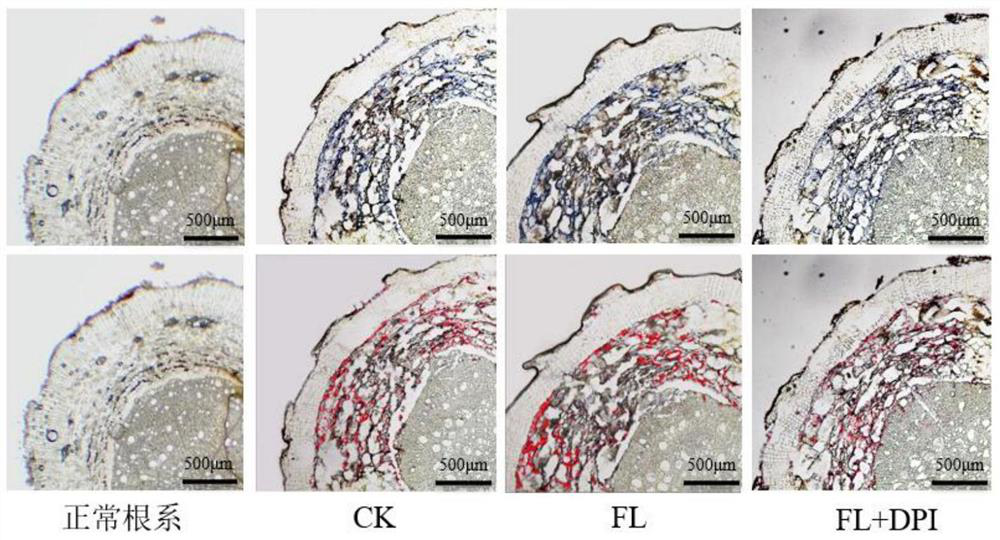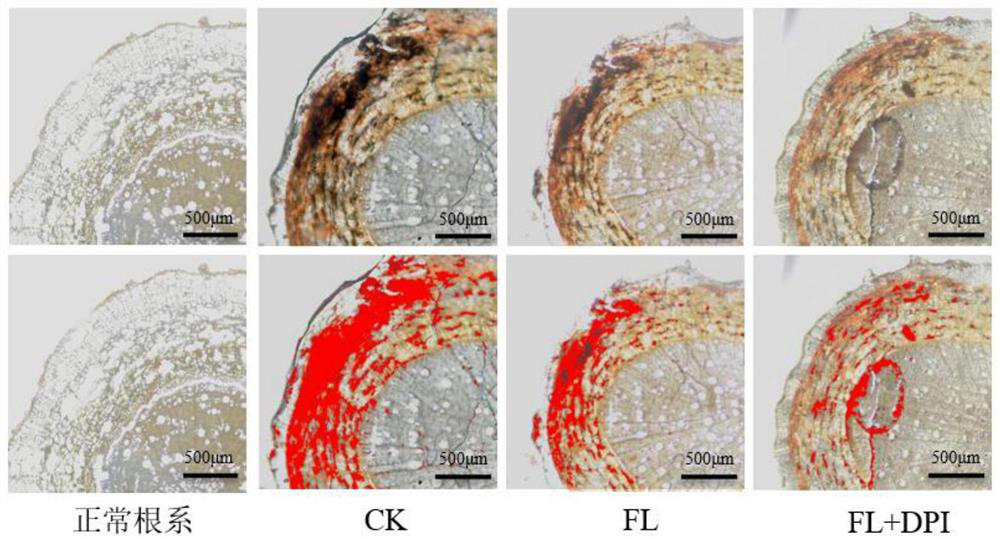Active oxygen rapid staining positioning method for plant root system
A plant root system, rapid dyeing technology, applied in the preparation of test samples, sampling devices, etc., can solve the problems of high loss of active oxygen, high wax melting temperature, inability to active oxygen, etc., to maintain the living form, accurate slice results, The effect of improving accuracy
- Summary
- Abstract
- Description
- Claims
- Application Information
AI Technical Summary
Problems solved by technology
Method used
Image
Examples
Embodiment 1
[0060] The steps of a method for rapid dyeing and positioning of plant root reactive oxygen species of the present invention are as follows:
[0061] 1. Root samples and treatment
[0062] Cut the plant root system with a diameter of 5 mm to a length of 1 cm, and quickly use a weight to fix the root system to the bottom of a 10 mL centrifuge tube.
[0063] 2. Staining of root samples
[0064] The vacuum tank of the vacuum device was pre-cooled to 0°C, and a pre-cooled ice bag was placed in it to keep the low temperature, and then the centrifuge tube was placed vertically into the vacuum tank.
[0065] Add detection O pre-cooled to 0°C 2 - The staining solution did not cover the sample.
[0066] After covering the vacuum tank, adjust the vacuum degree to -0.05MPa to reach the negative pressure state, and keep it for 2h for dyeing.
[0067] 3. Root sample fixation
[0068] After staining, take out the centrifuge tube quickly, discard the staining solution, rinse the sample...
Embodiment 2
[0082] The difference between this embodiment and Embodiment 1 is that: in step 2, the dyeing solution is used to detect H 2 O 2 In step 3, the buffer is: 100mmol / L potassium phosphate buffer at pH 6.9. The rest of the steps are the same as in Example 1.
[0083] Taking the root system of wolfberry as an example, the above-mentioned plant root active oxygen H 2 O 2 The rapid staining localization experiment of , the specific experiment is:
[0084] Setting: normal root group: no acupuncture, directly stained wolfberry root; CK group: stained wolfberry root after acupuncture for 72h; FL group: inoculated with Fusarium oxysporum after acupuncture, and then stained wolfberry root after 72h; FL+DPI Group: Diphenylene iodide chloride (DPI, active oxygen inhibitor) and Fusarium oxysporum were inoculated after acupuncture, and the roots of Lycium barbarum were stained after 72 hours. The dyeing of the above groups all used the method of Example 2 of the present invention. The e...
Embodiment 3
[0089] The steps of a method for rapid dyeing and positioning of plant root reactive oxygen species of the present invention are as follows:
[0090] 1. Root samples and treatment
[0091] Cut the plant root system with a diameter of 8 mm to a length of 0.8 cm, and quickly use a clamp to fix the root system to the bottom of a 10 mL centrifuge tube.
[0092] 2. Staining of root samples
[0093] The vacuum bucket was pre-cooled to 4°C, and a pre-cooled ice bag was placed in it to keep the low temperature, and then the centrifuge tube was placed vertically into the vacuum bucket.
[0094] Add detection O pre-cooled to 4°C 2 - The staining solution did not cover the sample.
[0095] After covering the vacuum barrel, adjust the vacuum degree to -0.08MPa to reach the negative pressure state, and keep it for 4h for dyeing.
[0096] 3. Root sample fixation
[0097] After staining, take out the centrifuge tube quickly, discard the staining solution, rinse the sample several times...
PUM
 Login to View More
Login to View More Abstract
Description
Claims
Application Information
 Login to View More
Login to View More - R&D
- Intellectual Property
- Life Sciences
- Materials
- Tech Scout
- Unparalleled Data Quality
- Higher Quality Content
- 60% Fewer Hallucinations
Browse by: Latest US Patents, China's latest patents, Technical Efficacy Thesaurus, Application Domain, Technology Topic, Popular Technical Reports.
© 2025 PatSnap. All rights reserved.Legal|Privacy policy|Modern Slavery Act Transparency Statement|Sitemap|About US| Contact US: help@patsnap.com



